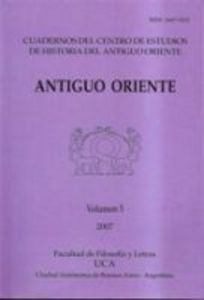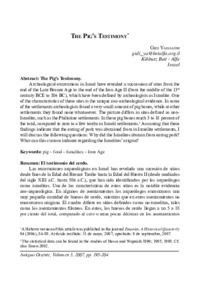Por favor, use este identificador para citar o enlazar este ítem:
https://repositorio.uca.edu.ar/handle/123456789/11909| Título: | The pig’s testimony | Autor: | Yahalom, Gidi | Palabras clave: | EDAD DE HIERRO; CERDO; YACIMIENTOS ARQUEOLOGICOS; ALIMENTOS; ISRAELITAS | Fecha de publicación: | 2007 | Editorial: | Pontificia Universidad Católica Argentina. Facultad de Ciencias Sociales. Departamento de Historia. Centro de Estudios de Historia del Antiguo Oriente | Cita: | Yahalom, G. The pig’s testimony [en línea]. Antiguo Oriente. 2007 (5). Disponible en: https://repositorio.uca.edu.ar/handle/123456789/11909 | Resumen: | Abstract: The Pig’s Testimony.
Archeological excavations in Israel have revealed a succession of sites from the
end of the Late Bronze Age to the end of the Iron Age II (from the middle of the 13th
century BCE to 586 BC), which have been defined by archeologists as Israelite. One
of the characteristics of these sites is the unique zoo-archeological evidence. In some
of the settlements archeologists found a very small amount of pig bones, while at other
settlements they found none whatsoever. The picture differs in sites defined as non-
Israelite, such as the Philistine settlements. In these pig bones reach 5 to 18 percent of
the total, compared to zero to a few tenths in Israeli settlements. Assuming that these
findings indicate that the eating of pork was abstained from in Israelite settlements, I
will discuss the following questions: Why did the Israelites abstain from eating pork?
What can this custom indicate regarding the Israelites’ origins? Resumen: El testimonio del cerdo. Las excavaciones arqueológicas en Israel han revelado una sucesión de sitios desde fines de la Edad del Bronce Tardío hasta la Edad del Hierro II (desde mediados del siglo XIII a.C. hasta 586 a.C.), que han sido identificados por los arqueólogos como israelitas. Una de las características de estos sitios es la notable evidencia zoo-arqueológica. En algunos de asentamientos los arqueólogos encontraron una muy pequeña cantidad de huesos de cerdo, mientras que en otros asentamientos no encontraron ninguno. El cuadro difiere en sitios definidos como no-israelitas, tales como los asentamientos filisteos. En estos, los huesos de cerdo llegan a un 5 a 18 por ciento del total, comparado al cero o unas pocas décimas en los asentamientos israelitas. Asumiendo que estos hallazgos indican que hubo abstinencia de consumo de cerdo en los asentamientos israelitas, discutiré las siguientes cuestiones: ¿por qué los israelitas se abstenían de comer cerdo? ¿Qué puede indicar esta costumbre con respecto a los orígenes de los israelitas? |
Cobertura Espacial: | Israel | URI: | https://repositorio.uca.edu.ar/handle/123456789/11909 | ISSN: | 1667-9202 | Disciplina: | HISTORIA | Derechos: | Acceso abierto | Fuente: | Antiguo Oriente Vol.5, 2007 |
| Aparece en las colecciones: | AO - 2007 nro.5 |
Ficheros en este ítem:
| Fichero | Descripción | Tamaño | Formato | |
|---|---|---|---|---|
| antiguo_oriente05.jpg | 6,54 kB | JPEG |  Visualizar/Abrir | |
| pigs-testimony-yahalom.pdf | 187,24 kB | Adobe PDF |  Visualizar/Abrir |
Visualizaciones de página(s)
83
comprobado en 30-abr-2024
Descarga(s)
85
comprobado en 30-abr-2024
Google ScholarTM
Ver en Google Scholar
Este ítem está sujeto a una Licencia Creative Commons

